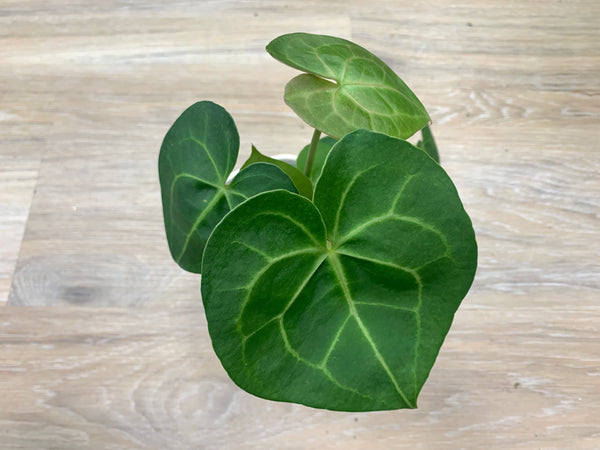Anthurium Pterodactyl: All About the Quirky Houseplant

A fun cultivar has taken flight in the plant world– the Anthurium ‘Pterodactyl’. With green leaves and pale-green, almost silver veining, this peculiar houseplant makes a statement. The veins are shaped in a way that resemble skeletal wings, like a Pterodactyl in flight. It’s also fairly small in stature with heart-shaped leaves that span only a few inches. The Anthurium ‘Pterodactyl’ is fairly low-maintenance and loved by Aroid collectors.
Origin: Cultivar – plant parents are native to Mexico
About
Considering the lineage of Anthurium ‘Pterodactyl’ and the fact that the plant descended from tropical regions, it naturally enjoys warmth and humidity. It’s an epiphytic plant, meaning that in the wild, it would attach to a tree, rock, or other surface in order to climb (usually upwards towards the sun).
While the parentage is unconfirmed, it’s most widely believed that the Anthurium ‘Pterodactyl’ is a cross between Anthurium clarinervium and Anthurium pedatoradiatum.

Buy Online: Anthurium ‘Pterodactyl’ — 4 Inch
Indoor Care:
Given that the Anthurium ‘Pterodactyl’s parents are native to tropical rainforests, the plant will enjoy conditions as similar as possible. Luckily, we can somewhat mimic these conditions indoors– at least to a level that’s satisfactory to the plant.
Sun
The best lighting for Anthurium ‘Pterodactyl’ will be moderate to bright, but indirect, sunlight. Typically the plant would be growing under the canopy level in the wild– so likewise, protecting it from harsh, direct sun rays is key to prevent leaf burns. Consider placing this plant near an east or west-facing window indoors. Keep in mind that some weaker sun exposure around sunrise or sunset is ok.

Water
Moderately watering is an important factor in keeping your Anthurium ‘Pterodactyl’ happy and healthy. Specifically, you’ll want to allow the top inch of soil to dry between waterings. This could mean watering only once a week to once every couple of weeks (depending on the conditions your plant is exposed too– like light, warmth, humidity levels).
When watering, make sure to do so thoroughly. Water should drain through the bottom holes of the pot, ensuring that all areas of the soil were moistened. But water should never be left standing at the bottom of the pot or drip tray (this can lead to root rot).
When in doubt, it’s best to underwater since it’s easier for the plant to bounce back from too little water than too much.
Some signs that the plant is underwatered may be curling or drooping leaves. On the other hand, if the leaves are experiencing yellowing, this could indicate overwatering issues.
Repotting
Anthurium ‘Pterodactyl’ will typically only require a repot once every year or so. So when exactly do you repot? If you see roots growing out of the bottom holes of the pot or if the roots are tightly and thickly coiled at the bottom of the pot– these mean the plant has likely outgrown the current pot and is ready for a little more wiggle room to grow.
When repotting, this plant will thrive with a well-aerated potting mix.
For more information on repotting find our guide here: Repotting 101.

Fertilizer
To sustain growth, your Anthurium ‘Pterodactyl’ will benefit from fertilizer during the active growing seasons. It’s important to remember that too much can actually harm the plant in the short and long term.
We recommend using a water-soluble fertilizer diluted to half the recommended strength. Fertilize once a month during spring and summer.
Pests
Spider mites, thrips, scale, and mealybugs are the most common houseplant pests that Anthurium experience. Try an all natural neem + soap mixture to combat and prevent infestations.
Toxicity
Anthurium plants are considered mildly harmful to humans, cats, dogs, etc. upon ingestion. The plant contains calcium oxalates that are insoluble and can cause irritation to the mouth, throat, and stomach.